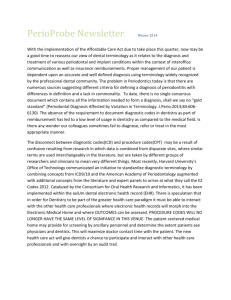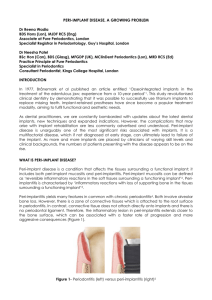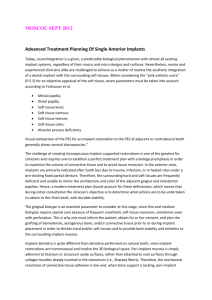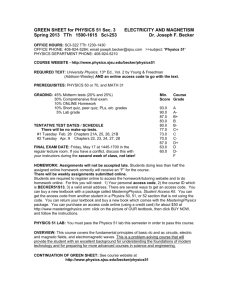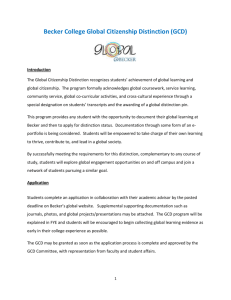Frank Schwarz, Jürgen Becker
advertisement
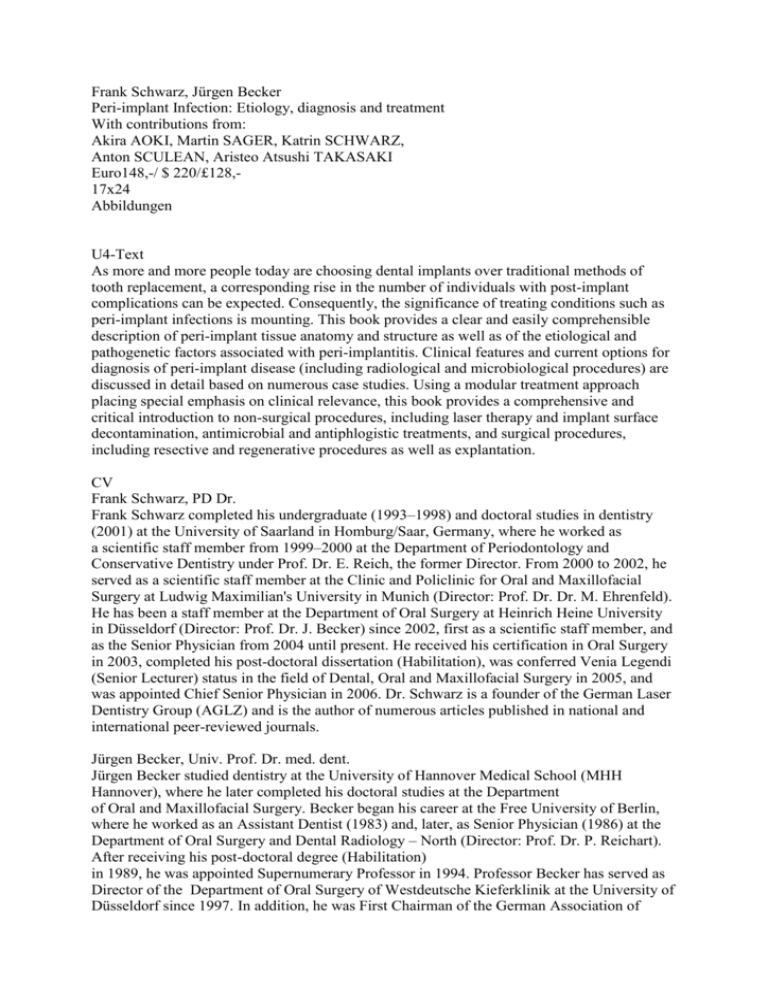
Frank Schwarz, Jürgen Becker Peri-implant Infection: Etiology, diagnosis and treatment With contributions from: Akira AOKI, Martin SAGER, Katrin SCHWARZ, Anton SCULEAN, Aristeo Atsushi TAKASAKI Euro148,-/ $ 220/£128,17x24 Abbildungen U4-Text As more and more people today are choosing dental implants over traditional methods of tooth replacement, a corresponding rise in the number of individuals with post-implant complications can be expected. Consequently, the significance of treating conditions such as peri-implant infections is mounting. This book provides a clear and easily comprehensible description of peri-implant tissue anatomy and structure as well as of the etiological and pathogenetic factors associated with peri-implantitis. Clinical features and current options for diagnosis of peri-implant disease (including radiological and microbiological procedures) are discussed in detail based on numerous case studies. Using a modular treatment approach placing special emphasis on clinical relevance, this book provides a comprehensive and critical introduction to non-surgical procedures, including laser therapy and implant surface decontamination, antimicrobial and antiphlogistic treatments, and surgical procedures, including resective and regenerative procedures as well as explantation. CV Frank Schwarz, PD Dr. Frank Schwarz completed his undergraduate (1993–1998) and doctoral studies in dentistry (2001) at the University of Saarland in Homburg/Saar, Germany, where he worked as a scientific staff member from 1999–2000 at the Department of Periodontology and Conservative Dentistry under Prof. Dr. E. Reich, the former Director. From 2000 to 2002, he served as a scientific staff member at the Clinic and Policlinic for Oral and Maxillofacial Surgery at Ludwig Maximilian's University in Munich (Director: Prof. Dr. Dr. M. Ehrenfeld). He has been a staff member at the Department of Oral Surgery at Heinrich Heine University in Düsseldorf (Director: Prof. Dr. J. Becker) since 2002, first as a scientific staff member, and as the Senior Physician from 2004 until present. He received his certification in Oral Surgery in 2003, completed his post-doctoral dissertation (Habilitation), was conferred Venia Legendi (Senior Lecturer) status in the field of Dental, Oral and Maxillofacial Surgery in 2005, and was appointed Chief Senior Physician in 2006. Dr. Schwarz is a founder of the German Laser Dentistry Group (AGLZ) and is the author of numerous articles published in national and international peer-reviewed journals. Jürgen Becker, Univ. Prof. Dr. med. dent. Jürgen Becker studied dentistry at the University of Hannover Medical School (MHH Hannover), where he later completed his doctoral studies at the Department of Oral and Maxillofacial Surgery. Becker began his career at the Free University of Berlin, where he worked as an Assistant Dentist (1983) and, later, as Senior Physician (1986) at the Department of Oral Surgery and Dental Radiology – North (Director: Prof. Dr. P. Reichart). After receiving his post-doctoral degree (Habilitation) in 1989, he was appointed Supernumerary Professor in 1994. Professor Becker has served as Director of the Department of Oral Surgery of Westdeutsche Kieferklinik at the University of Düsseldorf since 1997. In addition, he was First Chairman of the German Association of Dental, Oral and Maxillofacial Surgeons from 2001 to 2003. He is on the Scientific Advisory Board of the German Journal of Dentistry, German Journal of Dental Implantology, and German Journal of Oral and Maxillofacial Surgery. In 2004, Professor Becker resumed leadership of the German Task Force on Hygiene Requirements in Dentistry for the Committee on Hospital Hygiene and Infection Prevention at the Robert Koch Institute in Berlin. Preface As more and more people today are choosing dental implants over traditional methods of tooth replacement, a corresponding rise in the number of individuals with post-implant complications can be expected. Consequently, the significance of treating conditions such as peri-implant infections is mounting. Follow-up studies have shown that the prevalence of peri-implantitis currently ranges from 12 to 43% for most implant systems. Etiological and risk factors for the disease have been identified in a number of experimental and clinical studies performed in recent years. Diagnostic methods borrowed from periodontology have been adapted and extended to the implant-specific setting. In addition, a number of different non-surgical and surgical, resective and regenerative modalities are now available for treatment of peri-implantitis. This book was prompted by the often frustrating realization that many cases of treatment-resistant peri-implantitis lesions end in implant failure and explantation. The continuous development of new diagnostic and therapeutic methods has made it possible to prevent progression of the disease in most cases and to give these patients a long-term perspective for retention of their implant-borne restorations. Successful management of peri-implantitis requires a thorough understanding of the underlying medical and dental factors involved in the overall complex of the disease. Notwithstanding the recent advances in the field of modern implantology, periodontal regenerative therapy options should be considered carefully and given preference over implant restorations in certain cases. F. Schwarz J. Becker Contents 1 Anatomy of periodontal and peri-implant tissues F Schwarz and J Becker 1 1.1 Macroscopic anatomy 1 1.2 1.2.1 1.2.2 1.2.3 1.2.4 1.2.5 Microscopic anatomy of the periodontium 4 Epithelial structures 4 Connective tissue structures 6 Root cementum 6 Alveolar bone 7 Biological width and dentogingival complex 1.3 1.3.1 1.3.2 1.3.3 1.3.4 1.3.5 1.3.6 1.3.7 Bone growth 9 Morphogenic and mitogenic factors 10 Bone metabolism 11 Adaptive bone modeling/remodeling 14 Healing of extraction sockets 16 Bone atrophy 17 Physiological age-related involution 17 Dimensional changes of the alveolar ridge following tooth extraction 7 17 1.3.8 Preservation of the alveolar ridge 21 1.3.8.1 Extraction methods 21 1.3.8.2 Immediate implantation 21 1.3.8.3 Alloplastic semi-analog/root-analog implants 1.3.8.4 Guided tissue and boneregeneration 22 1.4 Microscopic anatomy of peri-implant tissues 1.4.1 Transmucosal aspect 26 1.4.1.1 Epithelial structures 27 1.4.1.2 Connective tissue structures 27 1.4.2 Endosseous part of titanium implants 32 1.4.2.1 The titanium oxide layer in osseointegration33 1.4.2.2 Surface design of the endosseous implant part 1.4.2.3 Initial and early stages of osseointegration 36 1.4.3 Biological width and dentogingival complex 2 21 26 33 40 Etiological factors 45 F Schwarz and J Becker 2.1 Primary etiological factor: Biofilms and plaque accumulation 2.1.1 Development and growth of oral plaque biofilms 46 2.1.2 Ligature-induced peri-implantitis model 49 46 2.2 2.2.1 2.2.2 2.2.3 2.2.4 2.2.5 2.2.6 2.2.7 2.2.8 Additive factors 56 History of periodontitis: microbiology of peri-implant infections 56 Genetic factors 59 Smoking and alcohol consumption 60 Occlusal overload 60 Mucosal conditions 61 Alveolar ridge defects/bone augmentation procedures 62 Gingivitis desquamativa 70 Systemic diseases/medications 71 3 3.1 Pathogenesis of peri-implant infections F Schwarz and J Becker Immune defense of infections 75 3.2 Non-adaptive immunity against infections 76 3.3 Adaptive immunity against infections 3.4 3.4.1 3.4.2 3.4.3 3.4.4 4 Histopathological phases of peri-implant inflammations Early peri-implant mucositis 78 Established peri-implant mucositis 78 Advanced peri-implant mucositis 80 Peri-implantitis 82 Clinical manifestations 87 F Schwarz and J Becker 75 77 78 4.1 Classification of peri-implant bone defects 89 4.2 Radiologic classification 5 Diagnosis 97 F Schwarz, M Herten, K Schwarz, J Becker 5.1 5.1.1 5.1.2 5.1.3 5.1.4 5.1.5 5.1.6 5.1.7 Clinical examinations 97 Index system for plaque biofilms 97 Index system for determination of the condition of peri-implant mucosa 98 Bleeding upon probing 99 Probing depth, gingival recession, clinical attachment level 101 Peri-implant sulcus flow rate 101 Suppuration and pus formation 105 Clinical evaluation of implant mobility 105 5.2 5.2.1 5.2.2 5.2.3 5.2.4 Radiologic diagnostics Intra-oral radiography Panoramic radiographs CT 110 Cone beam DVT 110 5.3 5.3.1 5.3.2 5.3.3 Microbiological and molecular genetics diagnostics Dark-field microscopy 115 DNA hybridization 115 Polymerase chain reaction 115 5.4 Prevalence of peri-implant infections 92 108 108 108 113 117 5.5 Non-plaque-induced gingival disorders 117 5.5.1 Histopathological examination 120 5.5.2 Exfoliative cytology 123 5.5.2.1 Clinical procedure 123 5.5.2.2 DNA image cytometry 123 5.5.2.3 Diagnostic interpretation of DNA histograms 5.5.2.4 Diagnosis of gingivitis desquamativa 126 125 6 Therapy 129 F Schwarz, A Aoki, A Takasaki, M Sager, A Sculean, J Becker 6.1 Primary objective of therapy 129 6.2 Hygiene phase 130 6.2.1 Optimization of oral hygiene 130 6.2.2 Treatment of periodontal disease 131 6.2.2.1 Fundamentals 132 6.2.2.2 Laser characteristics 132 6.2.2.3 Characteristics of laser radiation 133 6.2.2.4 Laser application to treat periodontal and peri-implant infections 134 6.2.2.5 In vitro studies on laser–tissue interactions of different laser wavelengths 136 6.2.2.6 Lasers: experimental and clinical studies on the treatment of periodontal disease 142 6.3 Explantation 154 6.4 6.4.1 6.4.2 6.4.3 Corrective phase: nonsurgical initial treatment 161 Mechanical therapy approaches 161 Influence on the morphology and biocompatibility of titanium implants 161 Removal of bacterial plaque biofilms from structured titanium implant surfaces 164 Antimicrobial and antiphlogistic therapy approaches 169 Histological studies on nonsurgical or surgical treatment of peri-implant disease 172 Clinical studies: peri-implant mucositis 179 Clinical studies: peri-implantitis 179 6.4.4 6.4.5 6.4.6 6.4.7 6.5 Corrective phase: surgical therapy 189 6.5.1 Decontamination and conditioning of the implant surface 189 6.5.2 Antimicrobial photodynamic therapy 191 6.5.3 General surgical principles 195 6.5.3.1 Incision 195 6.5.4 Surgical-resective therapy approaches 198 6.5.5 Surgical-regenerative therapy approaches 205 6.5.5.1 GTR and GBR 205 6.5.5.2 Requirements of membranes for GBR/GTR methods 206 6.5.5.3 Structure and characteristic features of collagen 207 6.5.5.4 Cross-linking and effects on biocompatibility 208 6.5.5.5 Biodegradation of available collagen membranes 210 6.5.5.6 Biodegradation and angiogenesis 210 6.5.5.7 Bone grafts and graft substitutes 212 6.5.5.8 GBR: histologic examinations 214 6.5.5.9 GBR: clinical examinations 217 6.5.5.10 GBR: histological studies on the treatment of peri-implantitis 6.5.5.11 GBR: clinical studies on the treatment of peri-implantitis 230 6.5.5.12 Soft-tissue management at peri-implantitis sites 252 6.5.5.13 Enamel matrix proteins 261 6.5.5.14 BMPs 262 7 Appendices 267 Appendix 1 Synopsis: Diagnosis of Peri-implant Infections 267 Appendix 2 Synopsis: Risk Assessment – Treatment of Peri-implantitis Appendix 3 Synopsis: Treatment of Peri-implant Infections Appendix 4 269 268 222 Documentation – Peri-implant Infections References Index 293 271 270
